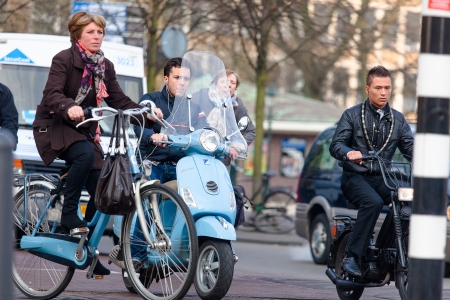Theoretically, it is to be expected that a cycle path will be less safe with larger numbers of users and with greater speed and mass differences between cycle path users (regular bikes, racing bikes, cargo bikes, pedelecs, light mopeds, light moped scooters). Observations during the morning rush hour on eight locations in the Hague and Amsterdam, however, found no direct link between the number of road users and their behaviour on the cycle path and the objective safety [7]. The diversity was found to be limited: more than 90% of the cycle path users had a regular bike. Light-moped riders are responsible for about 6% of the total group of cycle path users and thus contribute to the many users. Light mopeds (especially in scooter model) are also wider and light-moped riders overtook more frequently due to the speed difference.
However, per neighbourhood or per region the conditions can be different. Amsterdam, for example, has relatively narrow bike paths and a relatively high proportion of light mopeds and light mopeds scooters on its cycle paths. Based on a number of assumptions it has been estimated that it will be safer in Amsterdam traffic if light-moped riders – wearing a helmet– are moved to the roadway [8]. For the most part this safety gain will result from the expected mobility shift: as a result of the mandatory helmet use a large number of people will move to a safer mode of transport (public transport or car). Davidse et al. [3] comment that the speed differences between cars and light mopeds on 50km/h roads will be considerable as the legal maximum speed for light mopeds is 25 km/h. Due to the large differences in speed these researchers are of the opinion that light mopeds can only be moved to roadways with a 30 km/h maximum speed.
